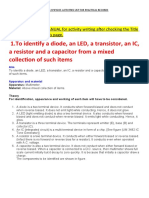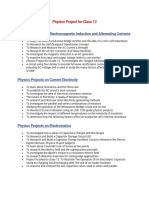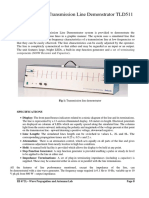Physics Project
Physics Project
Uploaded by
UmeshSwaroopCopyright:
Available Formats
Physics Project
Physics Project
Uploaded by
UmeshSwaroopOriginal Description:
Copyright
Available Formats
Share this document
Did you find this document useful?
Is this content inappropriate?
Copyright:
Available Formats
Physics Project
Physics Project
Uploaded by
UmeshSwaroopCopyright:
Available Formats
Yuva shakti model
school
Session :- 2014
subject :-
Factors affecting
internal resistance of a
cell
Made by :- UMESH
Class :- (xii - a)
submitted to :- MrS. INDRA RANI
Certificate
NAME : UMESH CLASS : XII
Enrolment No.
INSTITUTION :YUVA SHAKTI MODEL SCHOOL
This is certified to be the bonafide work of the
student in the PHYSICS INVESTIGATORY
PROJECT during the year 2014 .
............................
( Examiner )
acknowledge-ment
I , UMESH of class XII express my gratitude to my
school authorities for allowing me to undertake the
project entitled
' factors affecting internal
resistance of a cell '
I naturally could not have done justice to my delicate
assignment , had i not been privileged to get the animate
guidance from -
Mrs.______________, Physics teacher for higher
Secondary Classes of Yuva Shakti Model School
I also express sincere thanks to my family who
extended helping hand in completing this project.
Introduction
There is a great need of batteries in our daily use
electronic appliances and the use is increasing every day.
Thus , the batteries need to be made more powerful so
that their potential can be increased greatly .
Thus , this project report is based on practical analysis
for the factors affecting the internal resistance of a cell.
When the internal resistance of the cell is decreased we
can increase the potential difference across it , and hence
make it more reliable.
OBJECTIVE :-
To study the various factors on which the internal resistance of a cell depends.
Apparatus :-
A Potentiometer , a battery (battery eliminator) , two way keys , a rheostat of
low resistance , a galvanometer , a high resistance , an ammeter , a cell , a
Jockey , a set square , connecting wires , water bath , thermometer(0-100C) ,
burner , tripod stand , wire gauge .
theory :-
The internal resistance of a cell is the resistance offered by its electrolyte to
the flow of ions . The internal resistance of a cell
is directly proportional to the distance between the electrodes.
is inversely proportional to facing surface area of the electrodes in
electrolyte.
decreases with increase in temperature of electrolyte.
is inversely proportional to concentration of electrolyte.
The internal resistance of a cell is given by
r = (
)R
where
are the balancing lengths without resistance and with resistance
(shunt) , respectively and R is the shunt resistance in parallel with the given
cell.
procedure :-
Step 1
1. Draw the circuit diagram showing the scheme of connections.
2. Clean the ends of the connecting wires with sand paper and make tight
connections according to the circuit diagrams.
3. Tight the plugs of the resistance box.
4. Check the e.m.f. of the battery and cell and see that e.m.f. and see that
e.m.f. of the battery is more than that of given cell ,otherwise null or
balance point will not be obtained (E' >E).
5. Take maximum current from the battery , making rheostat resistance
small.
6. To test the corrections of the connections.(insert the plug in the key
and note the ammeter reading .Take out 2000 ohm resistance plug
from resistance box. Place the jokey first at the end P of the wire and
then at the end Q. If the galvanometer shows deflection in opposite
direction in the two cases the connections are correct).
7. Without inserting the plug in the key
adjust the rheostat so that a
null point is obtained on the 4th wire of potentiometer.
8. Insert the 2000 ohm plug back in the position in resistance box and by
slightly adjusting the jockey near the previous obtained position of null
point, obtain null point position accurately, using a set square.
9. Measure the balancing length
between the point and the end P of the
wire.
10. Take out the 2000 ohm plug again from the resistance box R.B. introduce
plugs in the key
,as well as in key
. Take out small resistance
(1-5 ) from the resistance box R connected in parallel with the cell.
11. Slide the jockey along the potentiometer wire and obtain null point.
12. Insert 2000 ohms plug back in its position in R.B. and if necessary make
further adjustment for sharp null point.
13. Measure the balancing length
from end P.
14. Remove the plug keys at
and
.Wait for some time and for the
same value of current (as shown by ammeter) repeat the steps 7 to 13.
15. Repeat the observations for diffrent values of R repeating each
observation twice.
16. Calculate the internal resistance of cell by using the above relation for r.
Step 2
To see the effect of distance between the electrodes on internal
resistances keeping the other factors constant ,vary separation between
electrodes and measure internal resistance in each case.
Step 3
To see the effect of the temperature of electrolyte on internal
resistance by keeping other factors constant.
Keep primary cells in water bath to heat the electrolyte. Determine
the internal resistance at various temperatures.
Step 4
To see the effect of concentration (nature) of electrolyte on
internal resistance by :-
Keeping the other factors constant , decrease concentration of electrolyte
by adding the distilled water and determine internal resistance of cell in
each case .
observations :-
S.No. Ammeter
Reading
Pos. of null point (
cm )
Shunt
Resistance
r=(
)R
( A ) With R (l
1
)
Without
R ( l
2
)
R ( )
1. 0.3 660.5 35.5 1 0.94
2. 0.3 660.5 77.2 2 1.77
3. 0.3 660.5 108.3 3 2.51
Table for effect of separation between electrodes :-
S.No. Separation
between
Balancing
length
Balancing
length
r=(
)R r/d
Electrodes-d (cm) (cm) ( l
1
) (cm) (l
2
) ( )
1. 1.2 326.6 276.9 0.456 0.38
2. 2.5 320.7 219.1 0.95 0.38
3. 3.7 660.5 350.9 1.406 0.38
table for effect of temperature :-
S.No. Temper-
ature
l
1
l
2
Resistan
ce
r=(
)R
Tr
(T) C (cm) (cm) R () () (K)
1. 40 325 12 1 0.96 301.44
2. 32 552 23.6 1 0.95 291.96
3. 27 660.5 35.5 1 0.94 283.87
Conclusions :-
1. The Electromotive Force of the cell is constant and is equal to
E = 0.98 Volt
2. The internal resistance of a cell is directly proportional to the separation
between the electrodes.
3. The internal resistance of a cell is inversely proportional to the area of
the electrodes dipped in electrolyte.
4. The internal resistance of a cell is inversely proportional to the
temperature of electrolytes.
5. The internal resistance of a cell is inversely proportional to the
concentration of the electrolyte.
Precautions :-
1. The connections should be neat , clean and tight.
2. The plugs should be introduced in the keys only when the observations are
to be taken.
3. The positive polls of the battery E and cells E1 and E2 should , all be
connected to the terminal at the zero of the wires.
4. The jockey key should not be rubbed along the wire. It should touch the
wire gently.
5. The ammeter reading should remain constant for a particular set of
observation. If necessary , adjust the rheostat for this purpose.
6. The e.m.f. of the battery should be greater than the e.m.f.'s of the either
of the two cells.
7. Some high resistance plug should always be taken out from resistance box
before the jockey is moved along the wire.
8. The e.m.f. of the battery should be greater than that of the cell.
9. For one set of observation the ammeter reading should remain constant.
10. Current should be passed for short time only , while finding the null
point.
11. Rheostat should be adjusted so that initial null point lies on last wire of
the potentiometer.
12. Cell should not be disturbed during experiment.
13. Jockey should not be rubbed against the potentiometer wire.
sources of error :-
1. The auxiliary battery may not be fully charged.
2. The potentiometer wire may not be of uniform cross-section and material
density throughout its length.
3. End resistances may not be zero.
You might also like
- Conforming To The Non-Conformity Yuen Kok Leong Ver 2.0Document17 pagesConforming To The Non-Conformity Yuen Kok Leong Ver 2.0Yuen Kok LeongNo ratings yet
- Physics ProjectDocument14 pagesPhysics Projectvidushimourya5No ratings yet
- Factors Affecting Internal Resistance of A CellDocument16 pagesFactors Affecting Internal Resistance of A CellChikkumol BabuNo ratings yet
- Anushka Das, Class 12G, Roll 13, Physics Investigatory ProjectDocument13 pagesAnushka Das, Class 12G, Roll 13, Physics Investigatory ProjectPriyanshu BanerjeeNo ratings yet
- Internal Resistance - PhysicsDocument31 pagesInternal Resistance - PhysicsAbhijith A.SNo ratings yet
- Physics Project Sample Copy Std. 12Document21 pagesPhysics Project Sample Copy Std. 12cytrfNo ratings yet
- Investigatory Project PhysicsDocument12 pagesInvestigatory Project PhysicsjeevanNo ratings yet
- DAV PUBLIC SCHOOL (Physics) XII ADocument14 pagesDAV PUBLIC SCHOOL (Physics) XII AAnish SahooNo ratings yet
- Vdocument - in Chemistry Project Class 12 Variation of Conductance of Electrolytes WithDocument22 pagesVdocument - in Chemistry Project Class 12 Variation of Conductance of Electrolytes WithSashi KanthNo ratings yet
- Satya Prakash Public School Physics ProjDocument17 pagesSatya Prakash Public School Physics Projharshsharma1513100% (1)
- Factors On Which The Internal Resistance Depend OnDocument14 pagesFactors On Which The Internal Resistance Depend OnThanyaNo ratings yet
- Investigatory ProjectDocument16 pagesInvestigatory Projectlittl miss72% (18)
- Wa0028.Document17 pagesWa0028.Omkar GhatageNo ratings yet
- Physics Investigatory Project Class XiiDocument18 pagesPhysics Investigatory Project Class Xiiriyacomputer0% (1)
- XII Physics Investigatory Project Factors-Affecting-Internal-resistanceDocument23 pagesXII Physics Investigatory Project Factors-Affecting-Internal-resistancecbse labNo ratings yet
- Physics Investigatory PROJECT: Name: Rahul MeenaDocument26 pagesPhysics Investigatory PROJECT: Name: Rahul MeenaRahul MeenaNo ratings yet
- Physics Project Class 12Document10 pagesPhysics Project Class 12Pratik Punj75% (4)
- 12th Physics Project PDFDocument17 pages12th Physics Project PDFRohan MehraNo ratings yet
- Class 12 Physics ProjectDocument14 pagesClass 12 Physics ProjectSRIJAN MANI TRIPATHINo ratings yet
- Phy PotentiometerDocument20 pagesPhy PotentiometerDanyRaj100% (3)
- D SanthoshDocument17 pagesD Santhoshsreejith9thattentive100% (1)
- Physics 12 Inv Daniel PDF 1Document19 pagesPhysics 12 Inv Daniel PDF 1Karan RajNo ratings yet
- Physics Project: Class:XII-B Roll Number:34Document6 pagesPhysics Project: Class:XII-B Roll Number:34SSTGNo ratings yet
- Physics Class 12 ProjectDocument33 pagesPhysics Class 12 Projectansh46190No ratings yet
- Physics ProjectDocument18 pagesPhysics ProjectAnime 4UNo ratings yet
- Physics Investigatory Project Abhishek Class Xii PDFDocument19 pagesPhysics Investigatory Project Abhishek Class Xii PDFRahulNo ratings yet
- Physics Investigatory Project Class 12 2Document18 pagesPhysics Investigatory Project Class 12 2Mukul ChowdharyNo ratings yet
- ʜʏsɪ S ƦDocument21 pagesʜʏsɪ S Ʀvinai PrasannaNo ratings yet
- List of ExperimentsDocument6 pagesList of ExperimentsNishika GuptaNo ratings yet
- Investigatory Project Physics EMFDocument20 pagesInvestigatory Project Physics EMFselena leeNo ratings yet
- Investigatory Project Physics 2Document19 pagesInvestigatory Project Physics 2Sunil SNo ratings yet
- Physics ProjectDocument16 pagesPhysics ProjectJoseph Sims67% (6)
- Charging and Discharging of CapacitorDocument22 pagesCharging and Discharging of Capacitormrvedant660No ratings yet
- Full Wave RectifierDocument15 pagesFull Wave Rectifiermandeep singhNo ratings yet
- Physics ProjectDocument11 pagesPhysics Projectshankaranand200517No ratings yet
- Class 12 Physics Practical ListDocument3 pagesClass 12 Physics Practical ListPragya100% (3)
- Chemistry Investigatory ProjectDocument15 pagesChemistry Investigatory ProjectArjit TiwariNo ratings yet
- Activities ListDocument15 pagesActivities ListHARSHA VARDAN KARTHIK SELVAN 6466100% (1)
- Mahalashmi Vidhya Mandhir Avadi: Light Dependent ResisterDocument25 pagesMahalashmi Vidhya Mandhir Avadi: Light Dependent Resisterkarthik srinivasanNo ratings yet
- Physics Investigatory Project Class 12Document16 pagesPhysics Investigatory Project Class 12new movies100% (1)
- Physics Investigatory Project CBSE 2017-18Document24 pagesPhysics Investigatory Project CBSE 2017-18Mukul100% (1)
- Investigatory ProjectDocument9 pagesInvestigatory ProjectMahesh Sahu69% (13)
- Physics Project 13 NovDocument19 pagesPhysics Project 13 NovAnish GargNo ratings yet
- Aayushi PhysicsDocument12 pagesAayushi PhysicsSameer pandeyNo ratings yet
- Physics Investigatory Project: by Tarun Singh of XII B, Manav Rachna International SchoolDocument11 pagesPhysics Investigatory Project: by Tarun Singh of XII B, Manav Rachna International Schoolraj60% (5)
- Physics Investigatory Project: Baps Public SchoolDocument22 pagesPhysics Investigatory Project: Baps Public SchoollakshmananNo ratings yet
- Physics Project SamDocument10 pagesPhysics Project SamKhushi ChaudharyNo ratings yet
- Chemistry IPDocument9 pagesChemistry IPMOHAMED IBRAHIMNo ratings yet
- ActivitiesDocument10 pagesActivitieskalashNo ratings yet
- Chemistry Investigatory Electrochemical CellDocument10 pagesChemistry Investigatory Electrochemical CellPriyansh ShuklaNo ratings yet
- Physics Investigatory Project - pptx-1Document26 pagesPhysics Investigatory Project - pptx-1Priybrat SharmaNo ratings yet
- Physics Investigatory Project On LDRDocument11 pagesPhysics Investigatory Project On LDRranjani100% (1)
- Physics Project On Series & Parallel CircuitDocument21 pagesPhysics Project On Series & Parallel CircuitPrabhat SinghNo ratings yet
- CBSE XII Chemistry Project Variation of Conductance With Temperature in ElectrolytesDocument19 pagesCBSE XII Chemistry Project Variation of Conductance With Temperature in ElectrolytesSubhash MittalNo ratings yet
- Physics Project For Class 12Document3 pagesPhysics Project For Class 12Pranjal KashaudhaNo ratings yet
- Samsung Ks3aDocument49 pagesSamsung Ks3aJanel WatsonNo ratings yet
- Factors Affecting Internal Resistance of A Cell1Document22 pagesFactors Affecting Internal Resistance of A Cell1SunnyChoudhary59% (29)
- Project On Factors Affecting Internal Resistance of CellDocument11 pagesProject On Factors Affecting Internal Resistance of CellVeenaGupta60% (5)
- PROJECT1 Project On Factors Affecting Internal Resistance of CellDocument12 pagesPROJECT1 Project On Factors Affecting Internal Resistance of CellrahulNo ratings yet
- Internal Resistance of Cell ProjectDocument12 pagesInternal Resistance of Cell Projectmandeep singh100% (1)
- Deepti Thakur-To-Study-The-Factors-On-Which-The-Internal-Resistance-Of-A-Cell-DependsDocument21 pagesDeepti Thakur-To-Study-The-Factors-On-Which-The-Internal-Resistance-Of-A-Cell-Dependsdhruv asatiNo ratings yet
- Hollinshead, K. (2021) - Thinking Imaginatively Via Generative Vitality in Tourism Studies (After Deleuze) - Journal of Tourismology, 7 (2), 149-170Document144 pagesHollinshead, K. (2021) - Thinking Imaginatively Via Generative Vitality in Tourism Studies (After Deleuze) - Journal of Tourismology, 7 (2), 149-170Δημήτρης ΑγουρίδαςNo ratings yet
- Mediakit For PublishersDocument16 pagesMediakit For Publishersapi-703302382No ratings yet
- Final Sponsorship Proposal Varchasva 2021Document17 pagesFinal Sponsorship Proposal Varchasva 2021The Artistic FeelsNo ratings yet
- Metals XRD PatternsDocument11 pagesMetals XRD PatternscirconaNo ratings yet
- Alaska Department of Fish and Game Press Release Concerning JBER Bear AttackDocument1 pageAlaska Department of Fish and Game Press Release Concerning JBER Bear AttackAlaska's News SourceNo ratings yet
- Title: Oracle Process ManufacturingDocument4 pagesTitle: Oracle Process ManufacturingmahfuzNo ratings yet
- MN116 - Whole-Course TutorialDocument11 pagesMN116 - Whole-Course Tutorialjordangeorge.66jNo ratings yet
- Ray Kroc Biography Yoheenis CalvoDocument7 pagesRay Kroc Biography Yoheenis CalvoYoheenis CalvoNo ratings yet
- List of Pokémon Episodes (Seasons 14-22) - WikipediaDocument144 pagesList of Pokémon Episodes (Seasons 14-22) - WikipediaManorama RasaniaNo ratings yet
- GHASNTDocument12 pagesGHASNTrhinemineNo ratings yet
- Vimal Chandra Grover Vs Bank of India On 26 April, 2000Document8 pagesVimal Chandra Grover Vs Bank of India On 26 April, 2000Taannyya TiwariNo ratings yet
- John Kaminski - The New Iron CurtainDocument4 pagesJohn Kaminski - The New Iron CurtainmsdfliNo ratings yet
- Smart Farm Management AnalysisDocument23 pagesSmart Farm Management AnalysisAll in all versionNo ratings yet
- Design and Vibration Analysis of A 2U-Cubesat Structure Using Aa-6061 For Aunsat - IiDocument8 pagesDesign and Vibration Analysis of A 2U-Cubesat Structure Using Aa-6061 For Aunsat - Iiபொன்னியின் செல்வன்No ratings yet
- Analysis of PyqDocument4 pagesAnalysis of PyqSubrat NandaNo ratings yet
- New Features in R12 Oracle Cash ManagementDocument50 pagesNew Features in R12 Oracle Cash Managementerpswan100% (1)
- JUST Reading and Writing PreDocument39 pagesJUST Reading and Writing PreFefo MichaelNo ratings yet
- Pusheen With Donut: Light Grey, Dark Grey, Brown, RoséDocument13 pagesPusheen With Donut: Light Grey, Dark Grey, Brown, RosémafaldasNo ratings yet
- Paez Case Study NotesDocument2 pagesPaez Case Study NotessNo ratings yet
- Assignment ON Advertisment: Atithi Devo BhavaDocument5 pagesAssignment ON Advertisment: Atithi Devo BhavajashanNo ratings yet
- Perhitungan Plat Lantai 4x4,0 DermagaDocument6 pagesPerhitungan Plat Lantai 4x4,0 DermagaBahranNo ratings yet
- Cookery - 10 - Summative - 1 - Quarter 4Document4 pagesCookery - 10 - Summative - 1 - Quarter 4Marie-Cris QuintoNo ratings yet
- 2021 Stroke Coat Brochure 1Document9 pages2021 Stroke Coat Brochure 1AmdNo ratings yet
- Automobile Sector in Odisha: EconomicsDocument3 pagesAutomobile Sector in Odisha: EconomicsSashiNo ratings yet
- 926 CatalogDocument782 pages926 CatalogJack Lay ParNo ratings yet
- Lab 1Document7 pagesLab 1Syed AsfandyarNo ratings yet
- Minarc: Classic 150Document2 pagesMinarc: Classic 150Florea SorinNo ratings yet
- The Value of American Dream As The Main Character of Life in The "The Greatest Showman" FilmDocument7 pagesThe Value of American Dream As The Main Character of Life in The "The Greatest Showman" FilmRIFA'ATUL LAILIYAHNo ratings yet
- Goma Con Nipa PalmDocument14 pagesGoma Con Nipa Palmetiele.grequeNo ratings yet

























































































